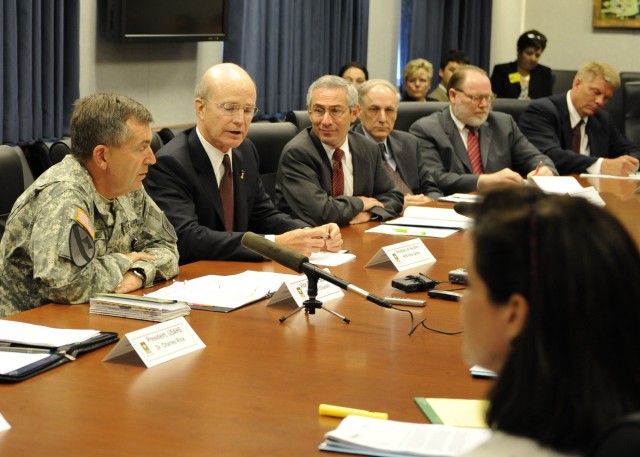
WASHINGTON (Army News Service, July 16, 2009) -- A ground-breaking study of behavioral health in the Army may soon provide answers on what causes suicide and what programs can best prevent them.
A media roundtable at the Pentagon Thursday provided an update on a five-year, $50-million study of suicide and behavioral health among military personnel, launched in October 2008, in partnership with the National Institute on Mental Health.
"We are working at all levels currently to do everything we can to reverse this trend, and we are excited about this partnership - this collaboration - with the National Institute of Mental Health, the Uniformed Services University [of the Health Sciences], and Harvard, Columbia and University of Michigan," said Army Secretary Pete Geren.
While the Army is now implementing many initiatives and programs to reduce suicide, Geren stated that the Army does not know which ones are most effective.
"We hope at the end of this study, we'll be able to make a better connection between 'this worked, this didn't work,'" said Geren.
Dr. Thomas Insel, director of NIMH, presented what he described as his "dream team" of researchers. The project director is Dr. Robert Ursano, chairman of the Department of Psychiatry at the Uniformed Services University of the Health Sciences in Bethesda, Md.
The research team also includes Dr. Ronald Kessler, professor of health care policy at Harvard Medical School; Dr. Steven Heeringa, director of the Statistical Design Group at the University of Michigan; and Dr. John Mann, vice chair for research at the New York State Psychiatric Institute and scientific director of the Kreitchman PET Center at Columbia University.
The idea of the study is to eventually understand pre-existing behaviors and factors that make Soldiers vulnerable to suicide, in addition to forming "actionable" results.
Army Vice Chief of Staff Gen. Peter Chiarelli described the Army's efforts to prevent suicide and promote wellness as "Assess, educate, train and intervene early," and provided an update on the Army Campaign Plan for Health Promotion, Risk Reduction and Suicide Prevention published in April 2009.
Although the suicide rate among Soldiers has traditionally been lower than among their civilian peers, last year the two rates became nearly the same.
There were no confirmed Soldier suicides in June, although 11 deaths are still under investigation. Geren noted that while the number of Army suicides has dropped since March 2009, it was too early to tell what factors, if any, could be credited.
"We're not here to tell you we think we have turned the corner; next month could be another tragic month. We are putting tremendous effort into this and perhaps the intervention that we have taught has helped avoid a suicide forever or it may have postponed it; we don't know," Geren said.
The Army required that every Soldier complete interactive suicide-prevention training earlier this year, followed by suicide-prevention chain teaching that units had until July 15 to complete.
"Although suicide can impact anyone, we're finding that male Soldiers, in combat-arms occupational specialties, between ages 18 and 27 are more vulnerable," said Brig. Gen. Colleen McGuire, director of the Army's Suicide Prevention Task Force, in a released statement.
Kessler described the work ahead as both an experiment and a study, because the demographics of the Army population will change over the next five years, and the Army is simultaneously implementing a range of programs to mitigate risk and improve Soldier resiliency.
Similar to the famous 1948 Framingham Heart Study of cardiovascular disease, the researchers plan to collect data from about 500,000 Soldiers over time, with approximately half of that number drawn from the ranks of the Army's 80,000 new recruits each year. The researchers will continue to study these Soldiers through the early stages of their career in hopes of determining which individuals are more predisposed to suicide and other mental health issues.
"Eventually, we want to see what we could have learned the first week they were in the Army that could predict how they would have responded when they got into a complicated situation," Kessler said.
Researchers will collect blood and saliva samples, hold psychological exams, and conduct interviews with families and unit leaders. They will also analyze archival data on Soldiers who have committed suicide, new cases of suicide, and surveys.
One critical aspect of the study is privacy. The researchers will use on-site data collection during training studies and confidential survey techniques. Soldiers will be asked to participate. The Army will not be testing recruits prior to enlistment.
"We will maximize the research utility, but protect the identity of the individual Soldier and their family," Heeringa said.
Updated results of the study will be released roughly every six months, beginning in November 2009.
In conclusion, Geren stated, "This is a matter of the highest urgency for the United States Army. We are doing everything we know to do now [to reduce the number of suicides], and as a result of this effort, in six months we'll be better, a year from now we'll be better, and five years from now we'll be better."

Social Sharing